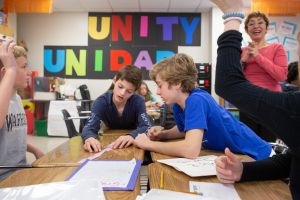Students come to our classrooms with a variety of backgrounds and knowledge, areas of expertise, and usually a love of talking. Talking about anything. They love to talk about their weekends, sports and activities they’re involved in, even things they probably shouldn’t share… we’ve all seen and heard it. But talking in class about content? We don’t hear that as much.
Whatever classroom we teach, talking is a critical part of learning. It’s important for students to dialogue in all content areas and subjects to grow vocabulary, hear differing opinions, and argue appropriately with peers. Research shows discourse supports a growth in expressive language which may help students’ reading comprehension (Lindsey, 2022). We know now, talking is a part of the puzzle that leads towards a proficient reader and learner (however, our ancient Greek philosophers already knew this) and must be incorporated into the learning environment, especially for our English language learners who need to hear the language or for students who may be at a linguistic disadvantage.
“Talking is a part of the puzzle that leads towards a proficient reader and learner.”

So the question remains, why does dialogue matter in the classroom? Well there are a few obvious reasons but let’s go over them. For one, it supports executive functioning. Language connects and supports the growth of our working memory (Goswami, 2015). It’s similar to building muscle- we have to consistently and intentionally strengthen it to withstand the information we are receiving and giving. Language is the interaction between thought and communication (Dastpak, 2017). We think therefore we are; however, communication is how we interact with one another as a species. This is what sets us apart from other animals. What about the relationship between learner and teacher? Talk deepens the relationships we strive for with our students (Gonser, 2021). Dialogue is critical for these areas of development.
We know it’s important, but what about the structure? We don’t want it to be disruptive, yet productive and beneficial for the learning environment. First, the environment must be set up to be successful. That looks like considering the various styles of responses students may orally respond with. Is it a “turn-and-talk”? A “think-pair-share”? What about the deeper levels of cognition and utilizing “write-pair and write-share” from Anita Archer? This is where students write down ideas prior to the pairing to deepen the level of accountability and then once paired, students write down the partner’s best ideas prior to sharing (Archer & Hughes, 2011).
“It’s important for students to dialogue in all content areas and subjects to grow vocabulary, hear differing opinions, and argue appropriately with peers.”
Even the “pause procedure” in Archer’s book (2011) discusses presenting material and then appropriately planning brief pauses for students to converse and chat about their notes (great for our older students). Whatever format you choose to use, consider these essential questions: What will it look like? What will it sound like? How will I give immediate corrective feedback? How will I monitor learning? This sets the stage for success. Pause right now and think about how this will look in your learning space. Make an action plan.
Remember, talk is critical. Appropriate productive dialogue is a must for our students to flex their working memories and connect thoughts with communication. It benefits all students, regardless of content area or subject. The important piece to consider is: how will it look/sound? When is it appropriate? What will I be doing to ensure success? Walk through the procedures with students – it takes time just like anything else we learn! Remember, we are setting our students up for success when we let them talk.
Resources
Archer, A. L. & Hughes, C.A. (2011). Explicit instruction: Effective and efficient teaching. The Guilford Press.
Dastpak, Mehdi & Taghinezhad, Ali. (2017). A Comparative Study of Vygotsky’s Perspectives on Child Language Development with Nativism and Behaviorism. International Journal of Languages’ Education.
Gosner, S. (2021, August 18). The magic of a noisy classroom. Edutopia.
Goswami, U. C., & Cambridge Primary Review Trust. (2015). Children’s cognitive development and learning. Cambridge Primary Review Trust.
Lindsey, J. B. (2022). Reading above the fray: Reliable, research-based routines for developing decoding skills. Scholastic.
Wright, W. (2016). Let them talk! Educational Leadership, 73(5), 24-29.
Please login or register to claim PGPs.
Alternatively, you may use the PGP Request Form if you prefer to not register an account.



